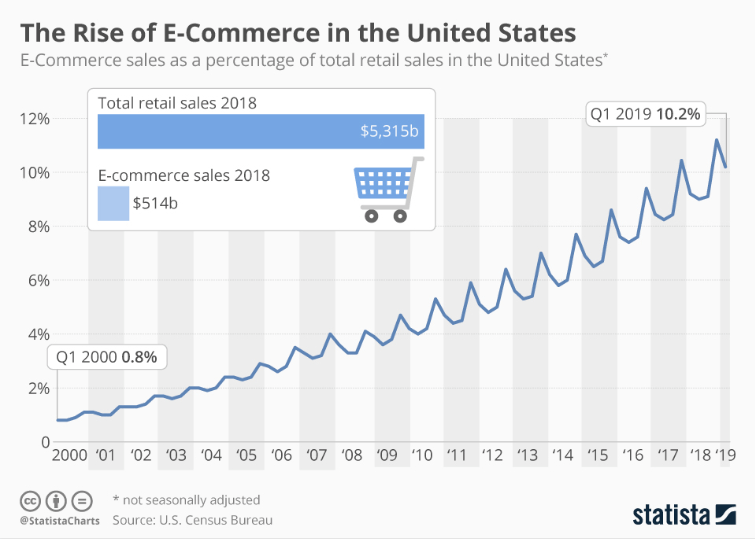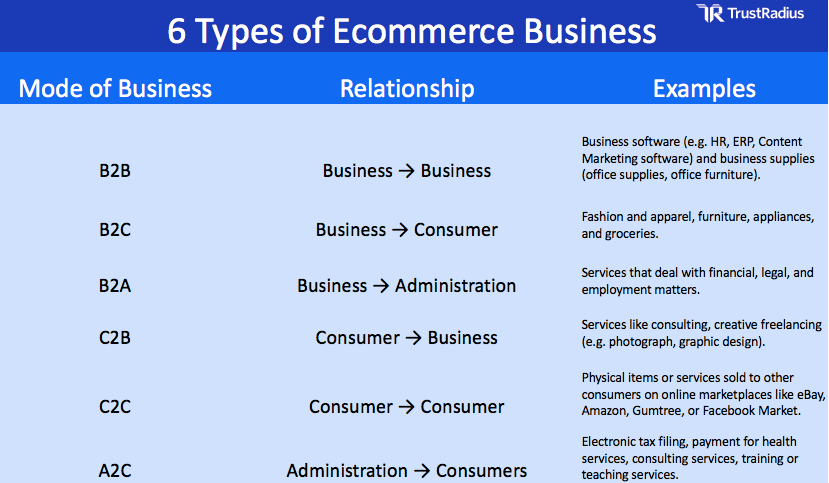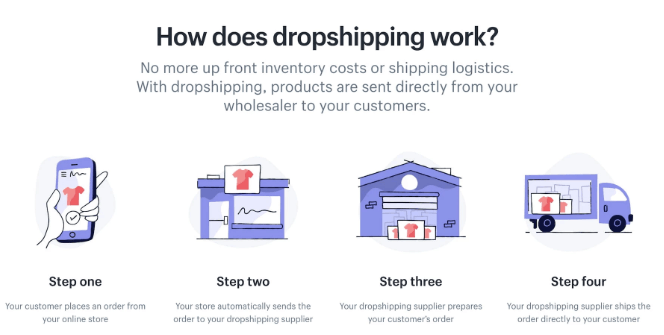Ecommerce 101: What Is Ecommerce?
This article will dive into the nitty-gritty of what exactly ecommerce is, the 6 main types of ecommerce businesses, different types of selling and fulfillment models, and give you a quick primer on what ecommerce software is.
Different Selling & Fulfillment Models
What is Ecommerce?
Whether you call it ecommerce, online transactions, e-commerce, or internet commerce—all these phrases refer to the same thing: the buying and selling of goods & services online. This naturally involves the exchange of information, usually payment and personal information, via the internet to conduct these transactions.
Ecommerce exclusively describes online transactions and doesn’t refer to other parts of a business that may be conducted via the internet. It also doesn’t apply when a consumer browses products online before making a purchase in person at a brick and mortar store.
Though it feels like ecommerce has been around forever, it’s actually still relatively new. Online buying and selling have been available to the public since the 1990s, starting with a small online book selling business that called itself Amazon. Flash forward a few decades and both Amazon and the ecommerce industry in general have expanded rapidly.

Even though ecommerce broadly refers to all types of online transactions, there’s a large degree differentiation in the industry when it comes to different types of online businesses, and their main mode of selling.
Types of Ecommerce Businesses
Get ready for acronym soup. There are 6 main kinds of ecommerce business that are alive and well today. Each of them involves two parties – either business, consumers, or government/school administrations – where one party sells goods or services to the other.
Here’s a breakdown of these 6 types and some examples of what sort of transactions fall under each (and a handy chart to keep track of them all):
#1 B2B
Business-to-business (B2B) transactions are when one business sells some type of good or service to another business. Some common examples include businesses that sell software or hardware to other companies (think of HR software, Microsoft Office, or any other tech you use at work), physical hardware like computers, and office supplies and furniture. Another common type of B2B sales happens when the producer of a consumer product (e.g. apparel, shoes, furniture, etc..) is sold to a wholesaler—aka another business that will then sell the product to consumers, typically for a healthy markup.
#2 B2C
Business-to-consumer (B2C) sales are some of the most common types of transactions, both in-person and online. But B2C ecommerce specifically refers to all the goods and services that consumers buy online. Many consumers get a lot of these goods from online marketplaces (e.g. Amazon, Etsy, eBay) or directly from retailers’ websites. Services like cell phone plans, cable, internet access, and video/music streaming services that individuals pay for online also fall into this category. Anything that consumers can buy from a business online is considered B2C ecommerce.
#3 B2A
Though business-to-administration (B2A) online sales may not be as prevalent as B2C or B2B ecommerce, they’re still essential types of transactions for organizations like government bodies, public works like libraries, and primary and higher education institutions. Common examples include transactions where businesses perform a service for these types of organizations, such as around social security, employment, and legal documentation or services.
#4 C2B
Consumer-to-business transactions describe transactions where individual consumers sell their goods or services to a business. Some activities that fall under this umbrella are freelancer services (e.g. photography, web design, graphic design), individual consulting services, social media influencer services, participating in paid focus groups or interviews, and leaving incentivized customer reviews. Overall, this type of online selling is less common than B2B or B2C.
#5 C2C
Consumer-to-consumer ecommerce involves transactions where one individual sells a good or a service to another individual. Many of these transactions are facilitated through online marketplaces such as Etsy, Craigslist, Amazon, and Gumtree where consumers purchase physical items. However, within the past decade, there has also been a rise in consumer services platforms like Airbnb, Uber, Lyft, GearShare, Rover, or Wag that provide a place for people to sell services (e.g. renting, ride-sharing, dog walking/sitting) to other consumers.
#6 A2C
The last type of ecommerce business is administration-to-consumer and is when consumers pay government administrations or other administrations for certain goods & services. Some examples include individuals paying for university tuition, paying to file state or federal taxes online through tax preparation websites, payment for health services, or government-funded training courses or certification programs. Many websites mistakenly label these types of transactions ‘C2A’, however, these are all examples of transactions where the administration is supplying the good/service and the consumer is paying for them.

Different Selling & Fulfillment Models
Along with these 6 types of ecommerce business models, there are also a variety of different modes of selling—i.e., the way that online businesses conduct transactions and deliver their products or services to their customers. There are four main methods of selling and delivery that include:
#1 Direct-to-consumer (DTC)
In the DTC method, the sellers make their goods or services directly available to their customers either online or in-person with brick & mortar stores. This cuts out costs associated with intermediary stores like department stores or wholesalers. Businesses can save even more money if they take an online DTC approach; costs associated with paying for and maintaining a physical storefront become nonexistent if your entire product catalog is online. DTC is a very popular retail channel, but can be used for other types of online transactions as well (e.g. B2B, C2B, A2C).
#2 Dropshipping
Dropshipping is an approach to ecommerce selling where the retailer purchases goods directly from the manufacturer which are then shipped directly to the customer. The main benefits for retailers are that they don’t have to keep any inventory in stock, they don’t have to purchase products before selling them to their customers, and they don’t have to handle the shipping logistics themselves. However, online businesses that want to set up a dropshipping model will need to find reliable dropshipping suppliers (businesses that will manufacture and ship the products) beforehand. This type of online selling and fulfillment works best for physical goods that can be purchased online.

#3 Wholesale
The wholesale method of selling is mainly used by B2B companies that buy large quantities of a product from a manufacturer or produce and then sells these to a retailer to then be sold to consumers. Typically, the wholesale company can acquire the goods at a lower, discounted cost since they’re purchasing the item in bulk. Though many wholesale companies are B2B, there are also some B2C companies that purchase wholesale items in bulk and sell the products at their own store for either a discounted price or marked-up price. These types of retailers are also called ‘warehouse clubs’ or ‘wholesale clubs’, examples include Costco, Sam’s Club, PriceSmart, or City Club.
#4 Online subscription
An online subscription selling model is when the customer pays a set price at recurring intervals (e.g. every week, month, or year), in return for an ongoing service or good. An online subscription selling model works better for non-physical goods or services, like a software subscription or online service (e.g. cable, internet, streaming platforms). However, physical goods like a monthly magazine, beauty, or clothing subscription would also fall under this type of online transaction. Both B2C and B2B companies often use this model of selling.
What Is Ecommerce Software?
An ecommerce platform is software that provides businesses with the tools needed to set up an online store and sell goods and services to their customers. Ecommerce platforms generally have 4 main capabilities at their core: the ability to set up an ecommerce website or online storefront, the ability to upload a product catalog and customize it, an online shopping cart, and a secure payment gateway and checkout process for customers.
Most ecommerce software will also include other capabilities that help you run your online business. These include inventory management tools, a content editor, SEO & marketing tools or integrations, a built-in contact database or CRM integrations, free or paid website themes, and analytics and reporting.
If you’re interested in selling goods or services online but might not be ready to design your own ecommerce website, there are other online selling options available.
Marketplaces like Amazon, Etsy, Facebook selling groups, and eBay allow businesses and individuals to sell their merchandise via the marketplace. There are also a wide variety of ecommerce plugins (e.g. WooCommerce, Shopify’s Buy Button) that can help turn pre-existing websites into ecommerce stores.
Types of Ecommerce Platforms
There are a few different types of ecommerce software to consider, each with their benefits and disadvantages. These main types are:
- On-premise ecommerce software
- Software-as-a-service (SaaS) ecommerce platform
- Open-source ecommerce software
On-premise
On-premise ecommerce software is downloaded and installed on a local computer server and managed and maintained by the ecommerce business. All parts of the software are managed by the business itself, including any updates or problems that need to be addressed.
- Benefits: The main benefit here is that on-premise platforms give online sellers the largest degree of freedom to manage and customize their software. Online sellers don’t need to rely on a third party for software updates, and can often achieve deep customization. Another large benefit is that site security and performance can be closely monitored and controlled. Businesses have complete control over their website and data security if they choose the on-premise model.
- Disadvantages: The main drawback to on-premise ecommerce software is that it requires an in-house developer, or team of developers, to manage and maintain the software. Not all businesses have the funds or bandwidth needed for this. The cost associated with on-premises software can also be a large detractor for many businesses. In addition to annual or semi-annual license fees, the cost of maintaining software itself can get expensive.
While there are still on-premise ecommerce platforms available in the market, such as Magento Commerce (formerly Magento Enterprise Edition), cloud-based ecommerce software has become incredibly popular. Most ecommerce vendors now offer a cloud-based solution as their main product or offer it alongside their on-premise option.
Software-as-a-Service (SaaS)
SaaS ecommerce platforms are cloud-based and typically managed and hosted by a third-party provider, and typically have an online subscription model where the business pays per month or year for access to the cloud services. Online sellers can access the platform through web browsers.
- Benefits: The main benefit of having a cloud-based ecommerce platform is that the third-party provider takes care of all the software upgrades, maintenance, troubleshooting, and security. This means that the costs associated with these activities essentially disappear for SaaS ecommerce platforms. These platforms are also typically easy to use, giving users with little to no coding experience the ability to customize the frontend of their online store using website themes or templates.
- Disadvantages: The key drawback of these types of platforms is that it’s hard to achieve the same level of backend customization since the software code is owned and maintained by a third party. Some users also feel like SaaS platforms are not as flexible and customizable as either on-premise or open-source ecommerce software in terms of being able to add new features or functionality on the backend of the platform.
Some examples of these types of platforms include:
Open Source
Open-source ecommerce platforms are open to the public and are free to use. They tend to be cloud-based, but can also be on-premise as well. In this case, business is responsible for all aspects of the open-source software, including code customization, upgrades and maintenance, security, performance, and support for integrations with third-party applications.
- Benefits: The biggest benefit of open-source platforms is that they’re free to use. Since the codebases for the software is available for anyone to use and customize, there tend to be large global developer communities where users can seek advice and help. Generally, open-source platforms also offer businesses the highest degree of freedom in terms of flexibility and customization of the software.
- Disadvantages: The two main drawbacks of using open-source software are: 1) users don’t have access to any customer support if they are experiencing issues, and 2) the full burden of managing and maintaining the platform falls completely on the user. This can often be a substantial investment of time and money.
Examples of open-source platforms that can support ecommerce stores include:
Was this helpful?
